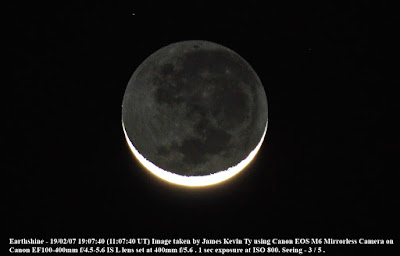Thursday, February 21, 2019
Solar Imaging Session - February 21, 2019
It has been months already since I did my last solar imaging session due to low solar activity as well as recent problem with my Vixen GP-DX equatorial mount (flexing cable) as well as my Nexstar alta-zimuth mount (worn out RA motor plastic gear). Since I was able to fix a bit my Vixen GP-DX mount cable, I opted this afternoon to test out the mount if it is running ok and since the Sun has a large dark filament visible now near the central meridian, I use this opportunity to image the filament using my old Borg 76ED refractor mounted on the Vixen GP-DX mount using a ZWO ASI120mm webcam and Daystar Quark Chromosphere Ha filter to capture it.
Tuesday, February 12, 2019
Lunar Imaging Session - February 12, 2019 (Waxing Crescent Moon ith Lunar X and V)
The sky this early evening was cloudy but it cleared up at around 8:00pm. Lunar X and Lunar V was best viewed earlier in the morning time at around 10:00am so by the time I took the image, sun ray had already pass the most favorable time to observe them by almost 10 hours. The best next favorable time to observe the next Lunar X and V will be March 13, 2019 around 11:00pm :)
Anyway, still happy to image the Moon using my Canon EOS M6 Mirrorless Camera on Canon EF 100-400mm f/4.5-5.6 IS L lens set at 400mm f/8 with an exposure of 1/500 sec at ISO 400.
Monday, February 11, 2019
Lunar Imaging Session - February 11, 2019 (Waxing Crescent Moon )
The sky this evening is clear but I'm so tired already so I just brought out my Canon EOS M6 Mirrorless Camera on Canon EF 100-400mm f/4.5-5.6 IS L lens set at 400mm f/8 on sturdy tripod to image the Waxing Crescent Moon with exposure of 1/250 sec at ISO 400.
Thursday, February 7, 2019
Lunar Imaging Session - February 7, 2019
The sky this evening is clear and I was able to spot the 2 day old thin crescent Moon after sunset. I use my Canon EOS M6 mirror less camera with Canon EF100-400mm f/4.5-5.6 IS L lens set at 400mm f/5.6 to capture the thin crescent Moon as well as Earthshine.
Subscribe to:
Posts (Atom)








